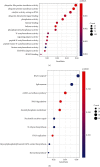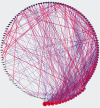Identification of Differentially Expressed Genes Particularly Associated with Immunity in Uremia Patients by Bioinformatic Analysis
- PMID: 36618529
- PMCID: PMC9815924
- DOI: 10.1155/2022/5437560
Identification of Differentially Expressed Genes Particularly Associated with Immunity in Uremia Patients by Bioinformatic Analysis
Abstract
Uremia is a common syndrome that happens to nearly all end-stage kidney diseases, which profound have changes in human gene expressions, but the related pathways are poorly understood. Gene Ontology categories and Kyoto Encyclopedia of Genes and Genomes pathways enriched in the differentially expressed genes (DEGs) were analyzed by using clusterProfiler, org.Hs.eg.db, and Pathview, and protein-protein interaction (PPI) network was built by Cytoscape. We identified 3432 DEGs (including 3368 down- and 64 up-regulated genes), of which there were 52 different molecular functions, and 178 genes were identified as immune genes controlled by the four transcription factors (POU domain class 6 transcription factor 1 (POU6F1), interferon regulator factor 7 [IRF7], forkhead box D3 (FOXD3), and interferon-stimulated response element [ISRE]). In the gender research, no significant difference was observed. The top 15 proteins of 178 immune-related genes were identified with the highest degree in PPI network. The DEG analysis of uremia patients was expected to provide fundamental information to relieve pain and add years to their life.
Copyright © 2022 Guixia Li et al.
Conflict of interest statement
The author(s) declare(s) that they have no conflicts of interest.
Figures







References
-
- Robinson B. M., Akizawa T., Jager K. J., Kerr P. G., Saran R., Pisoni R. L. Factors affecting outcomes in patients reaching end-stage kidney disease worldwide: differences in access to renal replacement therapy, modality use, and haemodialysis practices. The Lancet . 2016;388(10041):294–306. doi: 10.1016/S0140-6736(16)30448-2. - DOI - PMC - PubMed
MeSH terms
Substances
LinkOut - more resources
Full Text Sources
Miscellaneous

